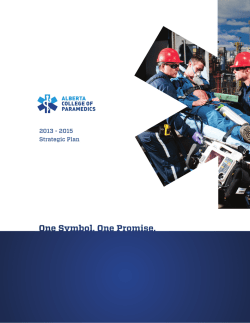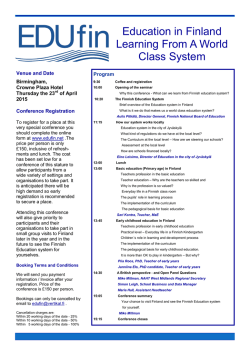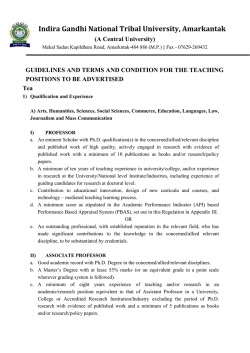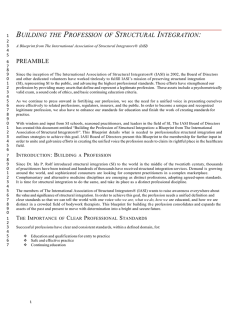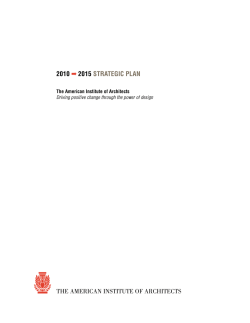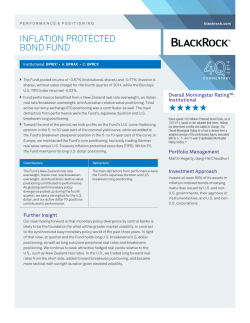
Strategic Plan 2014 – 2016
Strategic Plan 2014 – 2016 Positioning the profession to foster leadership in health information best practice to support quality healthcare HIMAA Strategic Plan 2014-16 Introduction The Health Information Management Association of Australia (HIMAA) has a long and proud history. Established by medical record librarians in 1949 with an initial focus on the capture and management of health information in Australian hospitals, through a number of organisational iterations the Association has retained a number of key focuses throughout its history which remain relevant today – advocacy, supporting members, training and education, professional development, the health information management body of knowledge, national conferences and international collaboration. In a constantly changing and evolving environment, HIMAA seeks to be responsive to change, to have an eye to the future, to remain relevant and to continue to add value within the healthcare environment. The previous two HIMAA Strategic Plans covering the past eight years have provided a solid foundation for HIMAA to have a mature strategic focus and increasing capability to influence change into the future which is reflected in this 2014-16 Strategic Plan. The HIMAA Board is excited by the capability and potential this Strategic Plan has to continue to advance the activities of the Association and of the health information management profession. The HIMAA Board would like to thank the many HIMAA members who have contributed to the research underpinning this Strategic Plan in the form of the 2013 HIMAA Membership Survey, the Focus Groups of August and September 2013, and the prioritisation of emerging themes at the 2013 HIMAA National Conference. Your voice has been heard and has significantly influenced the strategic direction identified for the next three years. This Strategic Plan belongs to you, our members, our staff and our governing committees, and Board of Directors. If you would like to contribute to any of the initiatives within the Strategic Plan, please contact the CEO at [email protected]. I look forward to your contribution to the achievement of the strategic priorities and initiatives over the coming three years. Sallyanne Wissmann President, HIMAA 16 May 2014 2 HIMAA Strategic Plan 2014-16 2014-16 HIMAA Strategic Plan At A Glance HIMAA’s 2014-16 Strategic Plan responds to membership direction by addressing workforce need, and emerging issues affecting the workforce such as ABF, eHealth and industrial matters, through three key strategic priority areas (SPAs): • • • Positioning and Advocacy Education Membership Vision HIMAA positions the profession to foster leadership in health information best practice to support quality healthcare. Mission HIMAA promotes and supports our members as the universally recognised specialists in information management at all levels of the healthcare system. We do this through positioning and advocacy, education and training, quality standards, publications and resources, and HIMAA membership networking activities at local and national levels, including an annual national conference of international standing. Strategic Priority Area 1: Positioning and Advocacy One of the best places for members of the profession to start addressing the impact of workforce shortages, and of other changes such as in eHealth and ABF, on the standing of the profession is with ourselves. In the Positioning and Advocacy SPA, HIMAA proposes a threefold strategy involving: • strategic HIMAA activities that advocate on behalf of the health information profession and better position members within their professional environment as a result; • the development and provision of resources to support members advocate on behalf of their profession in their own professional environment; and • communication of success stories at national and individual levels, both to the membership and to the stakeholder community Professional standards will underpin policy and positions which ensure a national standing for the profession in industry and will set the benchmark for jurisdictional awards and role classifications. Priority 1.1 Positioning the Profession HIMAA members will notice a greater awareness of and engagement with the health information management profession in the healthcare industry, amongst government and employers. We will be able to report an increase in the number of invitations from the healthcare industry and government to comment, make submissions and provide advice on behalf of the health information management profession. 3 HIMAA Strategic Plan 2014-16 Priority 1.2 Advocacy We will increase the amount and effectiveness of public advocacy that HIMAA undertakes on behalf of its members and the profession. Priority 1.3 Standing of the Profession HIMAA members will notice an increase in the credibility of the health information management profession as defined and promoted by their professional association. Priority 1.4 Diversification of and Specialisation in the Profession Members will see HIMAA’s support for diversification of and specialisation in the health information management profession result in their increased acceptance as valid career paths that exemplify health information management expertise. Priority 1.5 Health Information Management Research As a result of its engagement with industry, HIMAA will increase the volume and type of research conducted related to health information management. Priority 1.6 International Leadership HIMAA will further increase its international leadership activity in health information management. Strategic Priority Area 2: Education Education and training is a strategic key not just to the supply of the professional workforce in health information management, but also to credentialing in occupations such as Health Information Manager and Clinical Coder that improves the standing of the profession in the health system. The Education SPA involves strategic HIMAA initiatives to educate, train and develop health information management professionals in a context of: • sound and credentialed academic governance, and • a well communicated career and curriculum. Priority 2.1 Career Support and Advice We will focus on the provision of career support and advice, and the promotion of the HIM career pathway, in order to increase the number of people being educated and trained in the health information management profession through HIMAA accredited or delivered education and training services. Priority 2.2 Academic Governance HIMAA will increase in the number of HIMAA accredited, certified and credentialed health information management professionals. Priority 2.3 Clinical Coding Education and Training Continue to develop nationally recognised VET qualifications in clinical coding at Certificate IV and Diploma levels, and deliver these at home and overseas. Priority 2.4 Other Education and Training HIMAA will remain the provider of choice for health information management education and training in Australia and, increasingly, overseas. 4 HIMAA Strategic Plan 2014-16 Priority 2.5 Tertiary Education in Health Information Management HIMAA will work with course providers to increase the number of students enrolling in HIMAA accredited tertiary education courses. Priority 2.6 Professional Development We will work to increase in the number of HIMAA members and non-members who participate in HIMAA provided or HIMAA endorsed professional development activities, and strengthen our associated credentialing recognition for employers. Strategic Priority Area 3: Membership The broader the representation of the profession in our membership, the stronger the credibility of HIMAA advocacy and positioning activities. The more HIMAA credentialed professionals are members of the association, the stronger the authority of the profession’s standards in education, training and professional practice. The better the quality of networking within the profession, the stronger the value of professional unity. The Membership SPA involves strategic HIMAA initiatives to grow and support our members so that they can better network, access credentialed education and training, and advocate on behalf of the profession and its positioning within the health industry. Priority 3.1 Increasing and Retaining our Members The number of HIMAA members will increase as a result of HIMAA positioning and advocacy, education and training, and membership support activity. Priority 3.2 Membership Engagement We will be able to report an increase in the number of members actively participating in and contributing to HIMAA activities. Priority 3.3 Resources for Professional Practice There will be an increase in the number of current and relevant resources available to HIMAA members Priority 3.4 HIMAA National Conference The number of attendees at HIMAA’s national conference each year will increase, as will their perception of the conference as the primary annual lighthouse event for leadership and networking for health information professionals. 5 HIMAA Strategic Plan 2014-16 The HIMAA Strategic Plan 2014-16 About HIMAA The Health Information Management Association of Australia (HIMAA) is the professional association for health information management professionals in Australia. Our members work in a variety of roles within and supporting the healthcare system with the primary occupations being qualified Health Information Managers and Clinical Coders. HIMAA recognises that the health information management profession is broader than HIMAA itself. However, HIMAA considers itself to be the key influencer and definer of the profession. HIMAA is a not for profit organisation governed by a Board of Directors who are HIMAA members. The Association has a national office in Sydney staffed to deliver functionality in membership services, education and training, publications and resources, positioning and advocacy, communication and corporate services. Our peer-reviewed journal, the Health Information Management Journal is the only academic health information management journal in the world to achieve an international Thomson Reuters impact rating and DOI (digital object identifier) international citation referencing. HIMAA relies on the volunteer contribution of members to achieve its objectives and deliver organisational governance. Membership support is provided at the local level through networking and continuing professional development (CPD) provided by State and Territory branches, and nationally through our annual conference, which is of international standing. HIMAA also attracts members from a number of other countries including New Zealand. Vision HIMAA positions the profession to foster leadership in health information best practice to support quality healthcare. Mission HIMAA promotes and supports our members as the universally recognised specialists in information management at all levels of the healthcare system. We do this through positioning and advocacy, education and training, quality standards, publications and resources, and HIMAA membership networking activities at local and national levels, including an annual national conference of international standing. Values Member Focus We exist because of and for our members, offering them value in products, services, networking, advocacy and support Professionalism We provide high quality, ethical services based on well-informed judgement and expert knowledge of the Health Information domain Ethical Practice We are ethical in all of our operations and good stewards of our resources Equity We are equitable in the provision of services to our members, and treat everyone with respect 6 HIMAA Strategic Plan 2014-16 Background Research for the 2014-16 Strategic Plan The HIMAA Board undertook a more rigorous and extensive research process than in previous years to inform the 2014-2016 Strategic Plan. The Board is of the view that our members have a wealth of insight into the effectiveness of HIMAA and HIMAA’s efforts to support and advance the health information management profession, and the challenges and issues facing the profession that need to be addressed. In May and June 2013 a ‘2013 HIMAA Strategic Planning Survey’ was distributed to HIMAA members to which 30% of the total HIMAA membership responded. Members were asked to provide qualitative feedback on, amongst other things, the issues facing the health information profession currently, and in the next 5-10 years, and the top 3 priorities HIMAA should be addressing strategically and/or operationally. In August and September 2013, nine focus groups were held with member and non-member segments involving 65 people. These focus groups represented Clinical Coders, Health Information Managers (HIMs) in the public sector, Health Information Managers in the private sector, Health Information Managers in senior management/director roles, HIMAA Special Interest Group (SIG) and Committee chairs, Queensland attendees at a branch Professional Development Day, the HIMAA South Australian Branch Executive, La Trobe University educators, and lapsed members. Each of the focus groups was asked a standardised list of questions designed to assess HIMAA’s strategic performance to date and identify the strategic direction HIMAA should be taking in the next 3-5 years. In October 2013 at the HIMAA National Conference, a Strategic Plenary session was held with all attendees to present the findings of the membership survey and focus groups. Attendees were asked to prioritise a range of themes and sub-themes that had emerged from the research, including their top three priorities and the identification of a lower priority to be considered for elevation. Approximately 52 delegates completed this exercise, bringing the total number of membership contacts participating in the strategic planning process to 320. 7 HIMAA Strategic Plan 2014-16 Environmental Context At the initiation of this Strategic Plan, the following represents the environment within which HIMAA seeks to operate and influence. Healthcare Environment The 2010 Intergenerational Report projects health costs to increase from 15 per cent of all Commonwealth Government spending now (4.0 per cent of GDP) to 26 per cent by 2050 (7.1 per cent of GDP). The aging of the Australian population, associated increase in chronic and aged care needs, and increase in pan-population disease groups such as mental health, are attributed with the increase in costs, but the increasing availability of expensive health technology is another major factor. The 2010 National Health and Hospital’s Commission report, the National Primary Health Care Strategy (2008), the National Preventive Health Strategy (2009) and the 2011 COAG National Health Reform package provide a platform of initiatives to reduce health care spending long term, at the same time as improving quality of care. These initiatives respond to international evidence that primary care provides a more cost effective solution in general health outcomes than the secondary-quaternary care sector. They aim to improve quality of care in the primary sector and continuity of care between the primary and tertiary sectors to free up the hospital system to concentrate funds and resource on acute and short stay care. Initiatives over the last five years have included: • Parallel Primary Health Care and Health and Hospital Networks to enable regional planning and continuity of care; • Primary health care infrastructure (Medicare Locals) to create continuity of multidisciplinary care (GPs and Allied Health Professionals) to address mental health, chronic disease and other key health cost drivers; • A national electronic health record system built around the Personally Controlled Electronic Health Record (PCEHR), to enable a patient-controlled electronic health summary that can be shared between all care providers in the hospital and primary care systems; • The emergence of State- and Territory-wide electronic medical record systems ; • A Health Workforce Agency (HWA) to address health practitioner workforce demand, particularly in the primary health care sector; • Activity-based Funding (ABF) – a national reform of hospital and health service funding to ensure the funding dollar is distributed to the point of quality care; • Closing the Gap – a national initiative largely driven on aboriginal community controlled health principles to address the dramatic differential in health experienced by Indigenous Australians. In the last 2 years, the federal government has not actively progressed the reform agenda, with the word ‘reform’ disappearing from the ‘agenda’. The effectiveness of the initiatives that have been implemented is yet to be measured. Health Information Workforce Environment In 2010 an Australian Institute of Health and Welfare (AIHW) report on the Clinical Coding (CC) workforce estimated the combined CC/HIM workforce nationally to be around 3,500, with coders occupying almost two thirds (63.5%) of that population. It also reported that the Council of Australian Governments (COAG) had, just a year before (2009), acknowledged the nationwide shortage of health information professionals. The report estimated a 5 year workforce demand of double that of estimated supply (1,476), and almost double (3,101) the population of the profession at that time. 8 HIMAA Strategic Plan 2014-16 The HWA 2013 report on Health Information Workforce (HIW), released in December 2013, shows the health information graduate output (led largely by Health Information Managers) nose diving between 2006 and 2010 from 600 enrolments nationally to just under 300. By contrast, the report shows HIMAA Clinical Coder course enrolments increasing from 140 in 2007 to 250 in 2011. In 2014, HIMAA can confidently report enrolments approaching 600 a year. The HWA HIW report also draws on a Health Informatics Society of Australia (HISA) 2009 survey of 1300 heath informatics workers to show that health information is not the first choice of profession for many of the workforce. The HISA survey indicates that over two thirds of the HIW comes from other health professions, such as nursing and allied health. Neither HIMs nor CCs feature in this analysis, but HIMAA’s anecdotal experience is that enrolments in our clinical coding courses (initiated over 20 years ago specifically to address an apparent workforce shortage in the profession) draws notably on nursing and health administration occupations. The 2013 HWA report makes no current estimate of workforce demand in either occupation, but 2 of its 6 recommendations point to the need for support for recruitment strategies (such as education and training) in the existing occupations of known workforce shortage (HIM and CC) and the general promotion of health information (including health informatics) as a career. HIMAA membership research in 2013 provided the strongest indication yet that the loss of a degree HIM course in a state leads to HIM workforce shortage and, in turn, a combination of role substitution and downward pressure on existing qualified HIMs. Absence of a degree course in a state or territory exacerbates workforce shortage, leading to disparity in workforce supply between states and territories. As 2013 closed, Curtin University chose to axe its highly successful national graduate entry masters (GEM) course in HIM, despite HIMAA advocacy. Curtin’s degree courses appear to continue to reflect the university’s commitment to HIM, and La Trobe HIM continues to thrive in Victoria. In addition, QUT revived its HIM course in 2013 and has increased enrolments in 2014 by 50%. And in NSW, an exciting University of Western Sydney (UWS) HIM degree course innovatively built onto a Bachelor of Information and Communication Technology (BICT) degree looks set to commence in the near future. Challenges and Issues Facing the Profession As part of the research for the development of this Strategic Plan, members were asked to identify the challenges and issues facing the profession for both the next 5 years and for the future 5-10 years. The key challenges and issues facing the profession were identified by members as: The next 5 years: 1. Standing, visibility and positioning of the Profession 2. Workforce including workforce shortages, industrial issues, role substitution and institutional/performance pressure e.g. activity based funding, government policies, financial factors 3. eHealth and ICT 5-10 years: 1. Positioning the Profession 2. eHealth (and ICT) 3. Workforce shortage 4. Change management (need for) and funding/institutional pressures 9 HIMAA Strategic Plan 2014-16 Strategic Priority Areas for 2014-2016 Workforce issues emerged from HIMAA research as the driving force for HIMAA strategic priorities over the next 3-5 years, and beyond. While the standing of the profession in the face of institutional pressures was of primary concern, members also identified influences such as activity based funding (ABF) and eHealth as representing opportunities for the profession as much as threats to it. The identity of, opportunities for, and growth of the health information management workforce were common themes to emerge. The following strategic priority areas (SPAs) were validated from the research as the key functional themes through which HIMAA will address the workforce challenge over the next three years. 1. Advocacy and Positioning of the Profession 2. Education 3. Membership These SPAs are addressed individually below. Strategic Priority Area 1: Positioning and Advocacy One of the best places for members of the profession to start addressing the impact of workforce shortages, and of other changes such as in eHealth and ABF, on the standing of the profession is with ourselves. In the Positioning and Advocacy SPA, HIMAA proposes a threefold strategy involving: • strategic HIMAA activities that advocate on behalf of the health information profession and better position members within their professional environment as a result; • the development and provision of resources to support members advocate on behalf of their profession in their own professional environment; and • communication of success stories at national and individual levels, both to the membership and to the stakeholder community Professional standards will underpin policy and positions which ensure a national standing for the profession in industry and will set the benchmark for jurisdictional awards and role classifications. Priority 1.1 Positioning the Profession Outcomes: HIMAA members will report a greater awareness of and engagement with the health information management profession in the healthcare industry, amongst government and employers. HIMAA will be able to report an increase in the number of invitations from the healthcare industry and government to comment, make submissions and provide advice on behalf of the health information management profession. 10 HIMAA Strategic Plan 2014-16 Initiatives: 1.1.a Develop a value proposition for the profession to inform communication of a positioning strategy and its rationale. This will include the context of environmental change, organisational performance pressures, workforce pressures and a variety of health information management roles including rural and regional 1.1.b Identify and engage with potential change brokers in target groups with whom HIMAA can negotiate positioning improvement and identify structural targets (e.g. in government) capable of influencing positioning improvement for the profession, and engage in advocacy with these 1.1.c Promote policies, guidelines, submissions and other advocacy documents HIMAA develops so that these improve the positioning of the profession, including collateral related to workforce e.g. industrial awards and job classifications 1.1.d Identify specific opportunities for HIMAA to support specific members or member groups in better positioning the profession – for instance, in an industrial setting, with industrial agencies such as unions and employers – in order to provide case studies in success for the profession as a whole 1.1.e Develop and promote resources for HIMAA members to support individual engagement in positioning improvement for the profession e.g. mentoring, coaching, influencing literature; and profile member successes 1.1.f Develop and deliver a comprehensive communication strategy to disseminate HIMAA’s positioning messaging, including case studies, conference presentations, champion profiles, role models, positioning achievements, public advocacy and social media opportunities Priority 1.2 Advocacy Outcomes: HIMAA will increase the amount and effectiveness of public advocacy that it undertakes on behalf of its members and the profession. Initiatives: 1.2.a Beginning with a Workforce Strategy, develop an advocacy plan based on the initiatives identified in the Strategic Plan and in response to environmental changes 1.2.b Monitor the professional environment to identify emergent issues and opportunities for significant HIMAA advocacy on behalf of the profession 1.2.c Use a full range of advocacy interventions to advance HIMAA’s advocacy effort e.g. submissions, discussion papers, policy positions, letters, meetings, media releases, including in relation to workforce, education and health information management careers 11 HIMAA Strategic Plan 2014-16 1.2.d Communicate HIMAA’s advocacy outputs and outcomes to the membership, the profession and to key stakeholders and, where possible, to the community Priority 1.3 Standing of the Profession Outcomes: HIMAA members will report a noticeable increase in the credibility of the health information management profession as defined and promoted by their professional association. Initiatives: 1.3.a Continue to develop and publicise the knowledge domain and competencies of the health information management profession, including ensuring that the knowledge domain reflects and enables diversification of and specialisation in the profession 1.3.b Promote to employers and key stakeholders key indicators of the academic credentialing of the profession 1.3.c Develop and promote quality practice and safety standards for the profession, particularly in its two recognised occupations, Clinical Coder (CC) and Health Information Manager (HIM) 1.3.d Publicise member leadership, change champions and professional achievements of members 1.3.e Partner and collaborate with HISA on initiatives of relevance to health information management Priority 1.4 Diversification of and Specialisation in the Profession Outcomes: Members will report that HIMAA’s support for diversification of and specialisation in the health information management profession has increased their acceptance as valid career paths that exemplify health information management expertise. Initiatives: 1.4.a Support the development and activity of Special Interest Groups (SIGs) as examples of diversification and specialisation at the leading edge of the profession 1.4.b Increase activity in the national classification of occupations (ANZSCO) and in state awards and job classifications to support diversification and 12 HIMAA Strategic Plan 2014-16 specialisation from a core Clinical Coder/Health Information Manager base Priority 1.5 Health Information Management Research Outcomes: As a result of its engagement with industry, HIMAA will be able to report an increase in the volume and type of research conducted related to health information management. Initiatives: 1.5.a Develop a position statement on the value of health information management related research to the identification of best practice, the development of the profession’s knowledge domain and the advancement of the profession 1.5.b Promote health information management research and publication 1.5.c Coordinate with researchers and research institutions a health information management research agenda, including a research register 1.5.d Develop a funding strategy to support health information management related research, including scholarships and systematic reviews 1.5.e Continue to support initiatives to increase the impact factor of HIMAA’s peer-reviewed research journal, HIMJ Priority 1.6 International Leadership Outcomes: HIMAA will be able to demonstrate an increase in its international leadership activity in health information management. Initiatives: 1.6.a Contribute to international developments, initiatives and strategies to advance the health information management profession, particularly through fellow HIM organisations in other countries and the International Federation of Health Information Management Associations (IFHIMA). 1.6.b Provide specific strategic and practical support to health information professions in developing countries in our regional neighbourhood, including the Western Pacific, South East and South Asia. 13 HIMAA Strategic Plan 2014-16 Strategic Priority Area 2: Education Education and training is a strategic key not just to the supply of the professional workforce in health information management, but also to credentialing in occupations such as Health Information Manager and Clinical Coder that improves the standing of the profession in the health system. The Education SPA involves strategic HIMAA initiatives to educate, train and develop health information management professionals in a context of: • sound and credentialed academic governance, and • a well communicated career and curriculum. Priority 2.1 Career Support and Advice Outcomes: The increase in the number of people being educated and trained in the health information management profession through HIMAA accredited or delivered services will have a demonstrable impact upon workforce need. Initiatives: 2.1.a Define career pathways in health information management, particularly in its two ANZSCO listed occupations, Clinical Coding [599915] and Health Information Management [224213] 2.1.b Develop and implement a marketing strategy that promotes health information management career pathways and opportunities commencing notably in the secondary school system. 2.1.c Develop and implement a mentoring program to assist students and members who wish to attain or advance their level of professional practice Priority 2.2 Academic Governance Outcomes: HIMAA will be able to report an increase in the number of HIMAA accredited, certified and credentialed health information management professionals. Initiatives: 2.2.a To enhance HIMAA’s role as the national standards setter for health information management education and training, develop an academic governance strategy for the profession which: • links competency standards at the Clinical Coding (vocational education & training [VET]), HIM (tertiary) and Continuing Professional Development (CPD) levels to form an overall curriculum of professional lifelong learning • integrates accreditation, certification and credentialing functions into this curriculum framework 14 • HIMAA Strategic Plan 2014-16 extends HIMAA accreditation of external education and training providers/courses into the VET and CPD levels 2.2.b Develop HIMAA accreditation function in relation to overseas qualifications for migrant skills assessment for health information management occupations 2.2.c Develop and implement a matured credentialing scheme for health information management professionals including scope of practice, recognised credentials , and HIMAA approved professional development programs and activities 2.2.d Develop a HIMAA registration program for qualified health information management professionals 2.2.e Broker mutual recognition of Australian HIM qualifications by HIM associations in other countries, such as the US and Canada, in order to increase international mobility and exchange for HIM professionals around the world. Priority 2.3 Clinical Coding Education and Training Outcomes: HIMAA will deliver nationally recognised VET qualifications in clinical coding at Certificate IV and Diploma levels that are also sought overseas. Initiatives: 2.3.a Secure State and Federal Government funding to gain Community Services & Health Industry Skills Council (CS&HISC) and National Skills Standards Council (NSSC) endorsement of dedicated clinical coding VET qualifications at Certificate IV and Diploma level, or equivalent 2.3.b Develop, market and deliver VET qualifications in clinical coding at Certificate IV and Diploma level 2.3.c Encourage State and Territory Governments, and hospital health information managers themselves, to introduce clinical coder traineeship and placement schemes in the public and private healthcare sectors 15 HIMAA Strategic Plan 2014-16 Priority 2.4 Other Education and Training Outcomes: HIMAA will remain the provider of choice for industry-relevant health information management education and training in Australia and, increasingly, overseas. Initiatives: 2.4.a Develop high quality, industry relevant health information management courses that have a demonstrable impact upon workforce needs. 2.4.b Deliver such courses in response to industry demand, need and/or opportunity. Priority 2.5 Tertiary Education in Health Information Management Outcomes: HIMAA will be able to report an increase in the number of students enrolling in HIMAA accredited tertiary education courses as a result of HIMAA support for course providers. Initiatives: 2.5.a Continue to support the academic authority of the health information management degree courses particularly through the accrediting of health information management tertiary degree courses in Australia and overseas 2.5.b Develop and implement an engagement strategy with university partners to increase the awareness of and enrolments in health information management tertiary education 2.5.c Undertake, support and publicise research which demonstrates the workforce impact of the withdrawal or lack of local tertiary education in health information management Priority 2.6 Professional Development Outcomes: HIMAA will be able to demonstrate an increase in the number of HIMAA members and non-members who participate in HIMAA provided or HIMAA endorsed professional development activities 16 HIMAA Strategic Plan 2014-16 Initiatives: 2.6.a Develop and deliver a vibrant and varied professional development program of local and national activity to meet the needs of members to progress from entry level to advanced professional practice, including the areas of eHealth and ICT 2.6.b Develop a dedicated portal on the HIMAA website for such activity so that HIMAA becomes the “go to” website to find quality CPD events and activities 2.6.c Develop and market online education resources for health information management professional development Strategic Priority Area 3: Membership The broader the representation of the profession in our membership, the stronger the credibility of HIMAA advocacy and positioning activities. The more HIMAA credentialed professionals are members of the association, the stronger the authority of the profession’s standards in education, training and professional practice. The better the quality of networking within the profession, the stronger the value of professional unity. The Membership SPA involves strategic HIMAA initiatives to grow and support our members so that they can better network, access credentialed education and training, and advocate on behalf of the profession and its positioning within the health industry. Priority 3.1 Increasing and Retaining our Members Outcomes: The number of HIMAA members will demonstrably increase as a result of HIMAA positioning and advocacy, education and training, and membership support activity. Initiatives: 3.1.a Develop membership messaging that communicates the value of the profession and of professional association 3.1.b Develop and implement a marketing strategy to attract new HIMAA members from a variety of sources, promoting all membership categories and retaining existing members 3.1.c Develop and market the HIMAA Fellow membership category 3.1.d Introduce a range of membership achievement awards and acknowledgement criteria relating to membership and service, and provide appropriate recognition opportunities. 17 HIMAA Strategic Plan 2014-16 Priority 3.2 Membership Engagement Outcomes: HIMAA will report an increase in the number of HIMAA members actively participating in and contributing to HIMAA activities. Initiatives: 3.2.a Develop and implement a member engagement strategy that includes networking, participation and contribution opportunities 3.2.b Specifically promote the leadership development benefits of participation in HIMAA governance committees and sub-committees, and in special interest groups (SIGs) 3.2.c Provide a number of opportunities for members to profile and share their experiences and achievements as a health information management professional with other members 3.2.d Develop strategies and initiatives to support rural and regional HIMAA members, particularly through branches, networks and special interest groups. Priority 3.3 Resources for Professional Practice Outcomes: There will be an increase in the number of current and relevant resources available to HIMAA members Initiatives: 3.3.a Provide a dynamic, relevant and up-to-date member resource centre of online and material resources, tools, publications, articles, presentations and industry news and events 3.3.b Increase the number of member contributions to the HIMAA member resource centre 18 HIMAA Strategic Plan 2014-16 Priority 3.4 HIMAA National Conference Outcomes: There will be an increase in the number of attendees at HIMAA’s national conference each year, and in their perception of it as the primary annual lighthouse event for leadership and networking for health information professionals. Initiatives: 3.4.a Plan, market and deliver a high quality annual national conference that advances the health information management profession by providing state-of-the-art CPD from leading experts and practitioners, valuable networking opportunities and in other ways becomes the “must attend” event for health information management professionals (members and non-members) HIMAA Organisational Capability - Strategic Plan Dependencies In order for the above strategic priority areas and associated initiatives to be achieved, HIMAA needs a robust platform of organisational capability that continues to mature in terms of efficiency, effectiveness and good governance. While not called out as strategic initiatives in their own right, the following will need to be in place consistently and appropriately for the duration of this Strategic Plan. These will be the ongoing responsibility of the CEO and HIMAA Board to monitor and/or deliver. • • • • • • • • • • • • • • • Financial growth and capability so finances are available to support the strategic initiatives o In particular it is intended that a structured three-year business growth program for the organisation will demonstrate incremental improvements in each annual Board report to the membership Alignment with annual business planning and operations Staff, Board and member engagement HIMAA governance effectiveness and maturity Stakeholder engagement Consistently high quality customer service Responsiveness to member and stakeholder feedback Sufficient intelligence of changes in the professional environment to enable responsiveness Human resources available to plan, implement, sustain, monitor and review the strategic initiatives – both paid staff and member volunteers ICT capability and systems to support functions Website, social media presence and online collaboration capability Strategic Plan implementation plan Accountability Reporting of progress, and Evaluation of outcomes 19
© Copyright 2025
